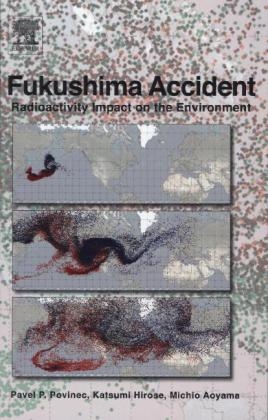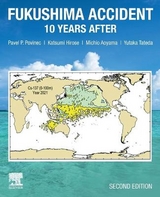
Fukushima Accident
Elsevier Science Publishing Co Inc (Verlag)
978-0-12-408132-1 (ISBN)
- Titel erscheint in neuer Auflage
- Artikel merken
Fukushima Accident presents up-to-date information on radioactivity released to the atmosphere and the ocean after the accident on the Fukushima Dai-ichi nuclear power plant, on the distribution of radionuclides in the world atmosphere and oceans, and their impact on the total environment (man, fauna, and flora). The book will evaluate and discuss the post-Fukushima situation, emphasizing radionuclide impacts on the terrestrial and marine environments, and compare it with the pre-Fukushima sources of radionuclides in the environment. The authors’ results, as well as knowledge gathered from the literature, will provide up-to-date information on the present status of the topics. Fukushima Accident is based on the environmental and nuclear research; however, the presentation will be suitable for university-level readers.
Prof. RNDr. Pavel P. Povinec, DrSc., Professor at the Faculty of Mathematics, Physics and Informatics of the Comenius University in Bratislava, retired Head of the Radiometrics Laboratory of the IAEA-MEL in Monaco, former Head of the Department of Nuclear Physics and Vice-Dean of the Faculty of Mathematics and Physics. He is recognized expert with over 50 years of experience in low-level radioanalytical and nuclear science (rare nuclear decays), in environmental (radionuclides as tracers, radiocarbon dating), and space physics (radionuclides in lunar samples and meteorites). At IAEA-MEL he was responsible for the development of radiometric (including underground laboratory) and mass spectrometry methods (ICP-MS, AMS) for marine radioactivity studies. He led several international projects on assessment of dumping of radioactive wastes, on impacts of nuclear weapon test sites, on worldwide marine radioactivity studies (WOMARS), on submarine groundwater discharge studies (SGD), on the development of global marine radioactivity databases (GLOMARD/MARIS), etc. After his return to the Comenius University, he established at the Faculty of Mathematics, Physics, and Informatics a Centre for Nuclear and Accelerator Technologies (CENTA) focusing on the development of IBA and AMS methods and their wide applications in nuclear, material, environmental, and biomedical sciences. In recent years he has been focusing on assessment of environmental impacts of the Fukushima accident. In 2017 he got Hevesy Medal Award for his contribution to nuclear sciences. He published more than 20 books and book chapters and more than 700 scientific papers with more than 12,000 citations (Google Scholar), organized more than 20 international conferences, and delivered more than 50 invited talks. Prof. Dr. Katsumi Hirose, Professor at the Laboratory for Environmental Research at Mount Fuji, Tokyo, former visiting Professor at the Sophia University in Tokyo, retired Head of the Geochemical Research Department of the Meteorological Research Institute in Tsukuba. He is internationally recognized expert with 45 years of experience in investigations of natural (cosmogenic, primordial, radiogenic) and anthropogenic radionuclides as tracers for better understanding of interactions between various objects in the systems as well as between different compartments/ecosystems, important for protection of the environment against radioactive contamination. His research carrier started from studies of metal complexation with organic ligands in solution at Nagoya University, conferred PhD degree from Nagoya University. Dr. Hirose worked at environmental radioactivity field including geochemistry, marine chemistry and atmospheric chemistry in Meteorological Research Institute. In the Marine Chemistry and Biogeochemistry field, Dr. Hirose developed chemical speciation of trace metals in seawater including plutonium and natural actinides based on physical chemistry. He was given Marine Chemistry Award “Ishibashi Award in 2006. In the field of environmental radioactivity, Dr. Hirose developed studies on marine and atmospheric behaviors of anthropogenic radionuclides especially plutonium as tracers, participating international projects and expeditions. He was given Geochemistry Award “Miyake Award in 2009. He made a large contribution to elucidate environmental effects and assessment for the Fukushima Daiichi Nuclear Power Plant accident in 2011. In the 45-years research carrier, he published over 220 scientific papers with more than 6000 citations (Google Scholar) and 16 books (including book chapters, reviews and others). Prof. Michio AOYAMA, DrSc, Visiting Professor at the Faculty of Life and Environmental Sciences of the University of Tsukuba, former Professor and presently Visiting Professor at the Institute of Environmental Radioactivity of the Fukushima University, and Invited Senior Scientist at the Research Institute of Global Change of the Japan Agency for Marine-Earth Science and Technology in Yokosuka. He is internationally recognized expert with 36 years of experience in investigations of anthropogenic radionuclides in the environment studying assessment and evaluation of radionuclides in the atmosphere and oceans, and in development of radioanalytical methods. He is also internationally recognized expert with 44 years of experience in hydrography and in the development of standard materials and quality assurance of salinity and nutrients measurements in seawater. He has been engaged in several major international projects in the field of ocean sciences, e.g. PC committee member in the WOCE WHP, Co-Chair of Joint IOC-ICES Study Group on Nutrient Standards (SGONS), Co-Chair of SCOR WG#147 Towards comparability of global oceanic nutrient data (COMPONUT), a member of SCOR WG#146 Radioactivity in the Ocean, 5 decades later (RiO5), leader of the SHOT project, etc. He was given Geochemistry Award “Miyake Award in 2014. He was also given two awards from the Oceanographic Society of Japan in 2018, simultaneously. One award was the Uda Prize for showing outstanding achievements at a group of environmental radioactivity in the marine environment and a group of global nutrients community, respectively. Another award was the Hidaka Outstanding-Publication Award for publishing two articles regarding the Fukushima accident released radionuclides in the North Pacific Ocean. In recent years he has been focusing on assessment of environmental impacts of the Fukushima accident. He published over 500 scientific papers with more than 7000 citations (Google Scholar) including 154 peer reviewed English articles, as well as 14 books. He is author and coauthor of 14 international reports and 10 data books. He presented over 20 invited talks at international conferences.
Prologue1. Introduction2. Fukushima Dai-ichi Nuclear Power Plant3. Fukushima Accident4. Radionuclide Releases into the Environment5. Fukushima Radioactivity Impact6. Pre-Fukushima Radioactivity of the Environment7. Estimation of Radiation Doses8. SummaryEpilogue
| Sprache | englisch |
|---|---|
| Maße | 191 x 235 mm |
| Gewicht | 810 g |
| Themenwelt | Naturwissenschaften ► Biologie ► Ökologie / Naturschutz |
| Naturwissenschaften ► Geowissenschaften | |
| ISBN-10 | 0-12-408132-0 / 0124081320 |
| ISBN-13 | 978-0-12-408132-1 / 9780124081321 |
| Zustand | Neuware |
| Informationen gemäß Produktsicherheitsverordnung (GPSR) | |
| Haben Sie eine Frage zum Produkt? |
aus dem Bereich



